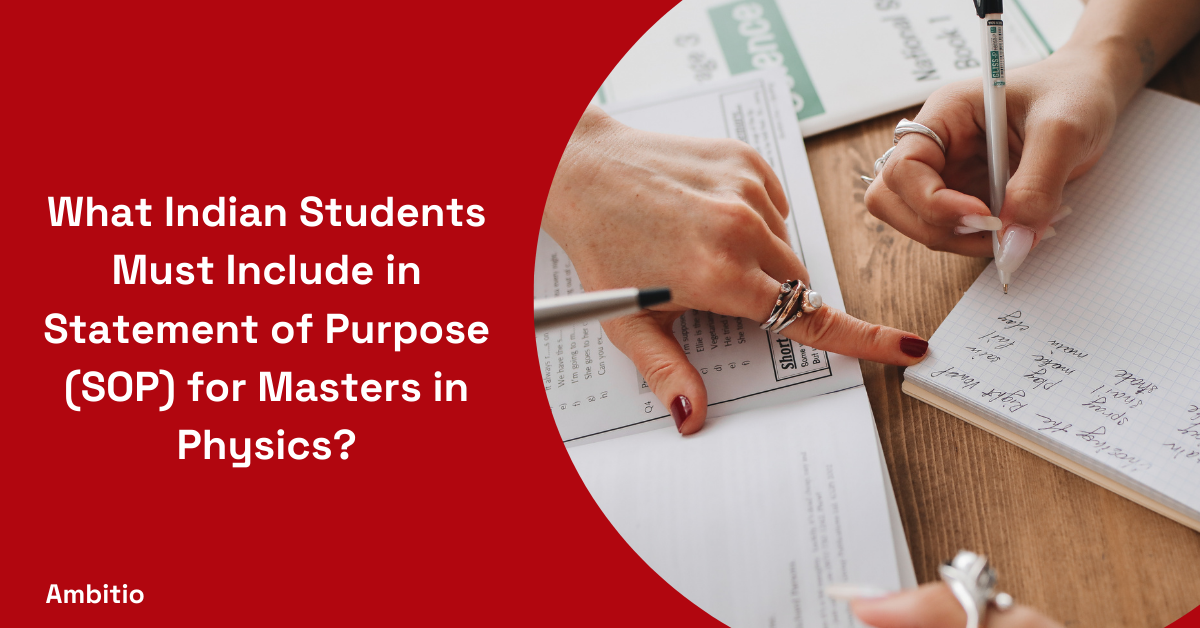21 April 2025
5 minutes read
What Indian Students Must Include in Statement of Purpose (SOP) for Masters in Physics?

Key Takeaways
- A standout statement of purpose for masters in physics is essential for Indian students to differentiate themselves in highly competitive graduate applications.
- Generic SOPs won’t work—admissions committees look for clear motivation, relevant research experience, and alignment with the program you’re applying to.
- Top universities like MIT, Stanford, and ETH Zurich expect structure, depth, and intent—treat your SOP like your academic pitch, not a summary of your CV.
Only 1 in 10 Indian students who apply to physics graduate schools abroad get shortlisted, not because they lack talent, but because their statement of purpose for masters in physics doesn’t reflect depth, clarity, or purpose.
Most SOPs from Indian applicants feel like templated essays. They skip over real research experience, offer vague academic goals, and ignore how their interest in physics aligns with the program they are applying to. If you’re serious about getting into a top graduate program, your SOP has to do more than just repeat your CV. It has to show who you are, what drives your scientific research, and why you’re well suited to pursue a master’s degree in physics.
Why Indian Students Need a Strong Statement of Purpose for Masters in Physics?
For Indian students, the statement of purpose for masters in physics is not just part of the masters degree application, it’s the single most powerful document in your entire grad school journey. Whether you’re aiming for an MS, PhD, or a prestigious physics masters program, your SOP decides if the faculty sees you as a serious candidate or just another name in the pool.

Top universities receive thousands of applications with similar grades, bachelor’s degrees, and even work experience. What sets you apart is your ability to communicate your motivation, research interests, and ambition in this one paragraph-driven essay. Are you interested in condensed matter? Want to explore quantum theory, mathematics, or theoretical physics? Mention the program you are applying to, the professor or institution you admire, and show them your solid understanding of the subject.
Use this space not as a template or sample from a random website, but as your personal chance to demonstrate your insight, your contribution to the discipline, and why you are the best student to achieve what you hope to become in your academic career.
Key Elements to Include in a Physics SOP for Indian Applicants
A well-written statement of purpose for masters in physics can be the deciding factor in your admission to a top graduate school. For Indian students, this is more than a personal statement, it’s a reflection of your enthusiasm, intellectual focus, and long-term vision. Whether you want to apply for a research-intensive PhD program later or just wish to pursue a specialized physics degree, the SOP should clearly show who you are, what fascinates you, and why you’re a good fit.

Use every paragraph wisely, and remember, what you submit as a final PDF speaks volumes about your quality as a candidate. Here are the key elements you must include:
- Clear Motivation and Fascination: What drew you to physics? What continues to intrigue you? Explain your academic journey and what sparked your interest.
- Academic Background: Talk about your bachelor’s in physics or related field, grades, relevant coursework, and any award or academic recognition.
- Research Interests and Experience: Mention any projects, papers, or areas like quantum mechanics or theoretical physics that you’re interested in or worked on.
- Future Goals and Fit: Describe how this master’s program aligns with your career goals, whether that’s entering a PhD program or contributing to the industry. Mention professors or research groups you want to work with.
- Diversity and Contribution: Show how your background, perspective, or ideas add diversity to the incoming class and how you’ll contribute meaningfully to the program.
- Professional Tone and Structure: Each paragraph must build on the last. Keep it clear, concise, and structured for readability. Ensure the final PDF is proofread and polished before you submit.
A great SOP isn’t just about passion, it’s about purpose, clarity, and alignment with the program you want to apply to.
How to Structure Your Statement of Purpose for Masters in Physics?
For Indian students, a well-structured statement of purpose for masters in physics can turn a good application into a great one. Admission officers don’t just look for passion—they look for clarity, flow, and intent. Here’s how to structure your SOP to leave a lasting impression:
- Introduction: Begin with a personal insight or moment that sparked your interest in physics. Keep it authentic and memorable.
- Academic Background: Highlight your educational journey, major achievements, and how they shaped your interest in physics.
- Research and Projects: Discuss specific projects or work experiences that deepened your understanding and commitment to the field.
- Career Goals: Clearly state your short- and long-term goals, and how the master’s program fits into your plan.
- Program Fit: Explain why you’re applying to that particular university and how it aligns with your interests.
- Conclusion: Reaffirm your motivation, express enthusiasm, and end on a confident, forward-looking note.
5 Tips to Make Your Statement of Purpose Stand Out for Top Physics Programs
Crafting a compelling statement of purpose for masters in physics is a key challenge many Indian students face, but it’s also your best chance to stand out. Here’s how to make yours impactful:
Start with a Unique Hook
Open with a personal insight or moment that sparked your love for physics—make it memorable from the first line.
Be Specific, Not Generic
Avoid vague statements. Clearly explain your academic journey, interests, and why you’re drawn to physics.
Show, Don’t Just Tell
Use real experiences and projects to demonstrate your curiosity, problem-solving, and drive.
Connect with the Program
Explain why the specific university fits your goals, mention relevant labs, faculty, or opportunities.
Keep It Focused and Polished
Stick to a clear structure. Proofread multiple times to ensure your statement of purpose for masters in physics reflects your best self as an Indian student.
10 Top Universities to Study Masters in Physics
Did you know that a Masters in Physics can open doors to cutting-edge roles in quantum computing, data science, and theoretical research, with starting salaries often exceeding $85,000 annually in global markets? The degree not only offers intellectual depth but also high return on investment when pursued at top institutions worldwide.
Here’s a quick comparison of the top 10 universities to study Masters in Physics, including average tuition, post-graduation salary, and exams required:
| University | Average Tuition Fees (USD/year) | Average Salary After Graduation (USD/year) | Exams Required |
|---|---|---|---|
| MIT (USA) | $57,590 | $95,000 | GRE, TOEFL/IELTS |
| Stanford University (USA) | $56,487 | $100,000 | GRE (optional), TOEFL/IELTS |
| Harvard University (USA) | $54,032 | $98,000 | GRE, TOEFL/IELTS |
| University of Cambridge (UK) | $38,000 | $85,000 | IELTS/TOEFL, MAT (rarely) |
| University of Oxford (UK) | $40,000 | $87,000 | IELTS/TOEFL, PAT (rarely) |
| ETH Zurich (Switzerland) | $1,500 | $90,000 | IELTS/TOEFL |
| University of California, Berkeley (USA) | $44,000 | $92,000 | GRE, TOEFL/IELTS |
| Caltech (USA) | $60,864 | $105,000 | GRE, TOEFL/IELTS |
| University of Toronto (Canada) | $24,500 | $82,000 | IELTS/TOEFL, GRE (optional) |
| LMU Munich (Germany) | ~$300 | $70,000 | IELTS/TOEFL |
Conclusion
Crafting a compelling statement of purpose for masters in physics is your chance to move beyond scores and showcase your passion, clarity, and readiness for graduate-level study. For Indian students, it’s not just about getting accepted, it’s about presenting a focused narrative that reflects your academic drive and research potential. If you’re struggling to structure or personalize your SOP, you’re not alone and you don’t have to do it alone.
Ambitio helps Indian students build standout SOPs with expert guidance, real examples, and one-on-one reviews. Ready to create an SOP that gets noticed? Start your journey with Ambitio Elite today.
FAQs
What is the purpose of a Statement of Purpose for a Master’s in Physics?
It explains your academic interests, motivations, and goals, showing why you are a good fit for the program.
What key elements should I include in my SOP for Physics?
Include your academic background, research interests, motivation, goals, and reasons for choosing the specific program.
How should I start my SOP to make it effective?
Start with a compelling introduction that highlights your passion and specific interests in physics.
How important is it to mention research experience in the SOP?
Very important, as it demonstrates your practical skills and commitment to the field.
Should I tailor my SOP to each university or program?
Yes, customizing your SOP shows genuine interest and alignment with the program’s strengths.
How long should my SOP be, and how should it be structured?
Typically 1-2 pages, structured with an introduction, background, research interests, goals, and conclusion.
What common mistakes should I avoid in my SOP?
Avoid vague goals, generic intros, irrelevant personal details, and failing to tailor it to the program.

You can study at top universities worldwide!
Get expert tips and tricks to get into top universities with a free expert session.
Book Your Free 30-Minute Session Now! Book a call now




























